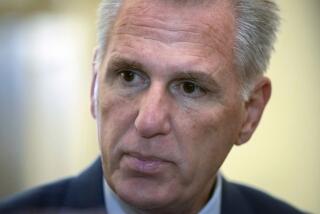Can U.S. prioritize payments as default looms? Many are dubious
WASHINGTON — If the debt limit isn’t raised by Thursday’s deadline, the cash flow problems of the world’s wealthiest nation could be boiled down to a simple mathematics equation: 10 is greater than 7.
The Treasury Department spends an average of $10 billion a day. It takes in about $7 billion in revenue a day. You don’t need to know calculus to figure out that’s not sustainable for long.
That’s only part of the trouble facing the federal government if it smashes up against its $16.7-trillion borrowing authority before Congress and the White House can work out a deal.
In addition to routine federal spending, the nation has big bills on the way — and major decisions about how to pay them with only $30 billion of cash on hand.
Short-staffed because of the shutdown, Treasury officials would have to figure out how to revise complex computer systems designed to pay bills as they come due. They’d also need to determine whether they have the authority to prioritize those payments.
Fitch Ratings, one of the nation’s three big rating companies, sounded doubtful. On Tuesday, analysts there put the nation’s AAA credit rating on watch for a potential downgrade.
“Although the Treasury would still have limited capacity to make payments after [Thursday], it would be exposed to volatile revenue and expenditure flows,” Fitch said. “The Treasury may be unable to prioritize debt service, and it is unclear whether it even has the legal authority to do so.”
Among the big bills coming due, the Treasury owes $12 billion in benefits to Social Security recipients on Oct. 23. Eight days later, it owes $6 billion in interest on government bonds.
And Nov. 1, the government owes a whopping $67 billion in another batch of Social Security checks, according to the Congressional Budget Office. The amount also includes payments to Medicare providers, salary for active duty military members, and retirement benefits for veterans and military and civil service retirees.
“It seems highly likely Treasury can get past Oct. 17. The trouble is every day you go past the 17th, the risk increases,” said Chris Krueger, a senior policy analyst at financial services firm Guggenheim Securities in Washington. “It’s kind of a zero-gravity environment. You don’t quite know what will happen.”
Some congressional Republicans have said Treasury would have enough money to make interest and principal payments due on government bonds, and by doing so could avoid a technical default.
But Treasury Secretary Jacob J. Lew has said prioritizing those payments still would constitute a default because the government would not be paying all its obligations. On top of that, the computer systems that process about 80 million payments a month are designed to pay bills as they are received, he said.
“You cannot go into those systems and easily make them pay some things and not other things,” Lew told lawmakers last week.
“So we’re going to be in a place which is uncharted territory,” he said. “It would not work smoothly. It would be chaos.”
The Treasury’s Financial Management Service bureau is in charge of the nation’s cash flow and paying its non-defense bills. In 2011, the latest statistics available, it paid more than $2.4 trillion in more than 1 billion individual payments to people and businesses.
The bureau has about 1,370 employees who work in Washington and regional centers in Philadelphia and Kansas City. Furloughs triggered by the shutdown have reduced the number of employees on the job to about 735, the Treasury Department said.
President Obama has said his administration was “exploring all contingencies.” But Treasury officials haven’t said whether they would try to prioritize payments.
At a Senate Finance Committee hearing Thursday, Lew would not commit to prioritizing payments on government bonds if the debt limit is not raised. He said the decision would be up to Obama.
Credit rating company Standard & Poor’s has said it believes the Treasury would continue to pay interest and principal on government bonds.
But experts said that would be difficult.
“From a systems standpoint, it’s almost virtually impossible for Treasury to do that,” said Robert Toomey, associate general counsel for the Securities Industry and Financial Markets Assn., a trade group.
Given the recent troubles the federal government had in launching the online exchanges for the healthcare reform law, it’s unlikely the Treasury could revise its systems quickly, said Shai Akabas, a senior policy analyst at the Bipartisan Policy Center think tank.
“If you’re trying to imagine the government could prioritize all of its millions of daily payments on a couple of weeks’ notice … and assure they could do that without glitches or problems, I think that’s a level of confidence the government probably doesn’t warrant,” he said.
Regardless, Treasury officials said they don’t believe they have the legal authority to make one payment instead of another because Congress hasn’t directed them to do that.
After the 2011 debt limit showdown, which was resolved before Treasury had to make any payment decisions, the Treasury Inspector General’s Office studied what was being considered by top officials.
No final plan for dealing with the debt limit was presented to Obama in 2011, the Inspector General’s report said. But Treasury officials said the department’s “organizational view” was that the least harmful option was to delay all government payments for a given day until they all could be made, the report said.
Under such a plan, payment delays “would have quickly worsened each day,” the report said.
The Bipartisan Policy Center estimated the Treasury would run out of money to pay all its bills between Oct. 22 and Nov. 1. The partial government shutdown has reduced spending and might give Treasury an extra day or two before it would be unable to pay all its bills, but that is unclear, Akabas said.
The only thing that’s certain is that Treasury will have exhausted all its so-called extraordinary measures for juggling the nation’s finances and will run out of borrowing authority by Thursday.
“It’s not necessarily that we can pinpoint a day when everything is going to blow up,” Akabas said. “It’s an increasing scale of uncertainty.”
More to Read
Inside the business of entertainment
The Wide Shot brings you news, analysis and insights on everything from streaming wars to production — and what it all means for the future.
You may occasionally receive promotional content from the Los Angeles Times.











